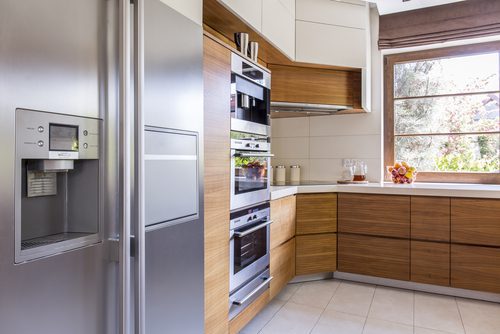Refrigerator, an essential kitchen appliance, has evolved over the years. Nowadays, refrigerators come in a range of colours, designs and sizes. Double door refrigerators are the latest offering by several popular brands. These refrigerators are spacious and suitable if you have a large family. Measuring the refrigerator also ensures if it fits properly in your home and allows you to plan your space. Further, it eases the process of delivery and its installation. In this article, we are sharing a few tips on how to measure a double-door fridge and estimate its size.
See also: How to defrost your refrigerator?
Standard size of a refrigerator
| Type of fridge | Size in inches (in) | Size in cubic foot (cuft) |
| Large | 36 width, 70 height and 33 to 35 depth | 22-28 |
| Medium | 24 to 32 width, 66 to 70 height and 29 to 36 depth | 20 |
| Small | 24 width, 60 to 75 height | 11-13 |
The size of a refrigerator will be based on the type of design, which are French door, side-by-side, top and bottom freezer. Standard refrigerators have a size range of 28¾ to 39¾ inch width, 61¾ to 71¼ inch in height and 28¾ to 34⅝ inch in depth. The depth may extend to 45 inch with the refrigerator door fully open. In cubic foot (cuft) specifications, standard refrigerators have sizes ranging from 20 to 25 cuft.

How to measure double door fridge size?
To measure a double-door fridge, start by measuring the fridge’s width, height, and depth. Provide space of a few inches to allow ventilation and let the doors open completely.
You will require tools, such as a measuring tape, pencil, and paper.
Step 1: Measure fridge width
Measure the distance from the wall to the counter, cabinet-to-cabinet or trolleys or anything on the side of the refrigerator. Provide at least two to three inch of space between the wall and hinge side to allow the door to open. With doors are ajar, depth may go up to 45 to 50 inch.
If you have chosen a counter-depth fridge, a design which aligns flush with countertops, will be a few inches wider than a standard fridge.
Step 2: Measure fridge height
If there are shelves or cabinets above your refrigerator space, measure from the floor to the bottom of the cabinets. If there is a platform below, you may consider the dimensions accordingly. A counter-depth refrigerator will be a few inch taller than the standard fridge.
Step 3: Measure fridge depth
To calculate the depth of a refrigerator, determine from the wall to the countertop’s edge. These dimensions should be around 24 to 25 inch in depth. Consider the following measurements of depth:
- Including fridge doors
- Excluding fridge doors
- Fridge closed (including handles)
- Fridge closed (excluding handles)
- Fridge doors open at 90 degree
- Fridge doors and drawers open
If there is a kitchen island or limited space, determine the area in front of the refrigerator to ensure that the doors can fully open.
Step 4: Measure ventilation space
After determining the refrigerator dimensions, add half an inch on:
- Either side of the fridge
- Above the fridge
- Between the back of the fridge and wall
This is essential to allow proper ventilation that allows the appliance to cool and prevents overheating.
Step 5: Measure refrigerator size in cubic foot
The total interior volume of a fridge has a size range from 10 to 25 cuft.
- To measure a refrigerator’ size, measure the refrigerator’s width, height and depth in inches.
- Now, multiply the three numbers.
- In the next step, divide the total number by 1,728. (One cubic foot is 1,728 cubic inch)
Make sure to remove the shelves and drawers, which helps you calculate the dimensions accurately.
For example, a refrigerator has width of 24 inch, height of 70 inch and depth of 24 inch. The measurement in cubic foot will be:
(24 X 70 X 24)/ 1,728 = 40,320/1,728 = 23.3 cuft
Step 6: Measure refrigerator delivery path
Before your purchase a refrigerator and book its delivery, determine the path from where it will be unloaded to the space and installed. For this, measure the width of each hallway and doorway. Avoiding hindrances, such as stairs, narrow turns, or doorways. Remove furniture and rugs on the way.
How to choose the right refrigerator for your home?
The ideal refrigerator size and style will depend on the available kitchen space and family size.
- Typically, a four to six cuft of refrigerator size is adequate for a person. Top-freezer and bottom-freezer refrigerator are available in four to 13 cuft size.
- A fridge with 20 cuft is suitable for a family of four. Bottom-freezer, top-freezer, French door and side-by-side refrigerators are available in 14 to 24 cuft size.
- A fridge with 25 cuft or above is ideal for a family of five or six.
FAQs
What is the size of a double-door fridge?
Double-door refrigerators are available in 4.75 to 5.5 feet (height), 1.75 to 2.66 feet (width) and 1.96 to 2.8 feet (depth).
Are double-door refrigerators bigger?
Double-door fridges, which are based on the side-by-side refrigerator model, are usually designed with multiple drawers and tiers and are spacious.
Are double door refrigerators beneficial?
Double-door refrigerators come with a larger capacity and can be used to store more items for your household requirements.
What size refrigerator is ideal for a family of three?
Refrigerators of 530 litre capacity, or 20 cuft is ideal for a family of three or four members.
What are the disadvantages of a double-door refrigerator?
Double-door refrigerators may be quite expensive and consume more energy.
| Got any questions or point of view on our article? We would love to hear from you. Write to our Editor-in-Chief Jhumur Ghosh at jhumur.ghosh1@housing.com |






